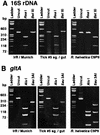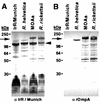Rickettsia monacensis sp. nov., a spotted fever group Rickettsia, from ticks (Ixodes ricinus) collected in a European city park
- PMID: 12200314
- PMCID: PMC124077
- DOI: 10.1128/AEM.68.9.4559-4566.2002
Rickettsia monacensis sp. nov., a spotted fever group Rickettsia, from ticks (Ixodes ricinus) collected in a European city park
Abstract
We describe the isolation and characterization of Rickettsia monacensis sp. nov. (type strain, IrR/Munich(T)) from an Ixodes ricinus tick collected in a city park, the English Garden in Munich, Germany. Rickettsiae were propagated in vitro with Ixodes scapularis cell line ISE6. BLAST analysis of the 16S rRNA, the citrate synthase, and the partial 190-kDa rickettsial outer membrane protein A (rOmpA) gene sequences demonstrated that the isolate was a spotted fever group (SFG) rickettsia closely related to several yet-to-be-cultivated rickettsiae associated with I. ricinus. Phylogenetic analysis of partial rompA sequences demonstrated that the isolate was genotypically different from other validated species of SFG rickettsiae. R. monacensis also replicated in cell lines derived from the ticks I. ricinus (IRE11) and Dermacentor andersoni (DAE100) and in the mammalian cell lines L-929 and Vero, causing cell lysis. Transmission electron microscopy of infected ISE6 and Vero cells showed rickettsiae within the cytoplasm, pseudopodia, nuclei, and vacuoles. Hamsters inoculated with R. monacensis had immunoglobulin G antibody titers as high as 1:16,384, as determined by indirect immunofluorescence assay. Western blot analyses demonstrated that the hamster sera cross-reacted with peptides from other phylogenetically distinct rickettsiae, including rOmpA. R. monacensis induced actin tails in both tick and mammalian cells similar to those reported for R. rickettsii. R. monacensis joins a growing list of SFG rickettsiae that colonize ticks but whose infectivity and pathogenicity for vertebrates are unknown.
Figures





References
-
- Altschul, S. F., W. Gish, W. Miller, E. W. Myers, and D. J. Lipman. 1990. Basic local alignment search tool. J. Mol. Biol. 215:403-410. - PubMed
-
- Andersson, S. G. E., D. R. Stothard, P. Fuerst, and C. G. Kurland. 1999. Molecular phylogeny and rearrangement of rRNA genes in Rickettsia species. Mol. Biol. Evol. 16:987-995. - PubMed
-
- Beati, L., P.-F. Humair, A. Aeschlimann, and D. Raoult. 1994. Identification of spotted fever group rickettsiae isolated from Dermacentor marginatus and Ixodes ricinus ticks collected in Switzerland. Am. J. Trop. Med. Hyg. 51:138-148. - PubMed
Publication types
MeSH terms
Substances
Grants and funding
LinkOut - more resources
Full Text Sources
Molecular Biology Databases
Research Materials

